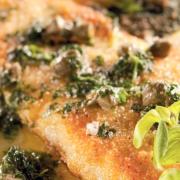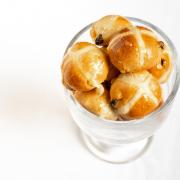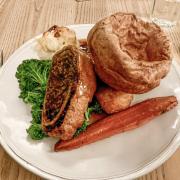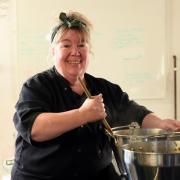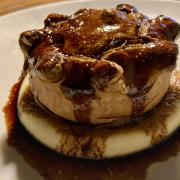In one of my favourite books - The Complete Cookery Year - the late great Gary Rhodes described April as ‘unpredictable’ when it comes to the weather and the availability of the much-anticipated springtime ingredients and flavours in the kitchen.
The book was written way back in 2002, yet it’s still a go-to for me and so many other cooks of a certain age, though I fear in 2024, things are ever more unpredictable.
I’m always tempted to offer up summery lighter dishes, but think we are just on the cusp of warmer days and not yet into al fresco or barbecue territory, but similarly the dark days of pies and puddings seem to be long gone.
So, this month’s recipes are bit of a mix-up of spring flavours with a nod to the somewhat inclement weather.
Lamb has to take a starring role. I did this dish in my first book Hughes Cooking when it was considered to be quite weird and wonderful, and probably elicited more comments than anything else I’d cooked in years.
In truth, the classic lamb dish of Kleftico, an undisputed classic of Greek cuisine, was a feast of stolen lamb, carried away by bandits who buried it deep in a pit of coals with straw and peat overnight, ready for the returning poachers to dig it up and eat their stolen supper, so the technique has been around for centuries.
Today we see hay-smoked cream panna cottas and ice creams, charred leeks and onions, burnt apple purees; who’d have thought that these dishes would become ‘de rigueur’ in so many ambitious chefs’ repertoires!
I’m serving my lamb with some fried hispi or sweetheart cabbage, another ingredient that’s found favour recently.

It’s really fashionable, and absolutely delicious, on the barbecue, or quickly fried with soy, ginger and peanuts. I’ve added bacon to mine, but just see what’s in your fridge. I could just eat a big bowl of this and disregard the main event.
I did say April wasn’t a month for puddings, but there is never a wrong time to eat a bread and butter pudding: it is my absolute favourite.
It’s a dish that’s nearly always on the menu at the Assembly House, mainly because I want to eat it two or three times a week.
Our head of pastry genius Mark Mitson makes the best one ever. I always say, if something works, then leave it well alone, however I have been known to make it with hot cross buns, brioche or, as here, with croissants. (NEVER with brown bread, thought, that really is a capital offence!).
After all, you can never use too much butter!

Leg of lamb baked in hay recipe
Serves six
Ingredients
1 leg of lamb, bone in, weighing approximately 3kg
Olive oil
1 bunch of fresh rosemary
12 garlic cloves
A large handful of clean, fresh hay
Salt and black pepper
Method
1. Wash the hay in cold water, rinse and repeat twice. Drain. Shake well to lose any excess moisture, leaving the hay damp to the touch.
2. Preheat the oven to 180C, Gas Mark 4.
3. Make a dozen or more small incisions in the lamb with a small knife, inserting the slivers of garlic cloves into each cut. The more you like garlic, the more incisions you can make and the more garlic you can add!
4. Place small sprigs of the rosemary into the same incisions, pushing well into the lamb. Season the leg of lamb liberally with salt and freshly milled black pepper.
5. Heat a large frying pan with a little olive oil. Brown the leg of lamb all over.
6. Take two large sheets of foil. Cover with the hay. Place the lamb on top and wrap tightly.
7. Place in a roasting tray and put into the preheated oven for one hour and 45 minutes if you like your lamb slightly pink. Add another 30 minutes if you want it well done.
8. Remove from the oven and rest for 15 minutes before unwrapping and carving.

Hispi cabbage with bacon and pinenuts recipe
Serves four
Ingredients
1 large cabbage
2 rashers of streaky bacon
25g pinenuts
¼ nutmeg
Salt and black pepper
Method:
1. Trim and dice the bacon.
2. Slice the cabbage.
3. Fry the bacon in a dry pan and add the pinenuts.
4. Fry for a few minutes, stirring occasionally.
5. Add the cabbage and continue to fry the mixture, stirring well.
6. Grate the nutmeg over the cabbage.
7. Season with salt and black pepper.
8. Pile on to a serving dish and decorate with a tiny sprinkling of nutmeg.

Baked croissant pudding recipe
Serves four
Ingredients
5 croissants
2 eggs
2 egg yolks
60g butter
250ml single cream
100g raisins
50g caster sugar
½ teaspoon cinnamon
½ vanilla pod
A dash of Grand Marnier, Amaretto or cherry brandy (optional)
Sprinkle of icing sugar
3 dessertspoons apricot jam
Method:
1. Halve the croissants and butter generously.
2. Simmer the raisins in a little water for five minutes.
3. Whisk the egg yolks with the sugar.
4. Bring the cream to the boil with the vanilla pod (scrape it to disperse the seeds) then simmer for three minutes.
5. Remove the cream from the heat, add the cinnamon and whisk.
6. Whisk together the cream, eggs and sugar.
7. Place most of the buttered croissant halves into a bowl and add the raisins.
8. Strain the custard mixture on to the croissants. Finish with the croissant tops and more custard.
9. Put the dish in a tray with hot water halfway up. Bake at 190C/Gas Mark 5 for 45 minutes until the custard is set.
10. Warm the jam and glaze the top of the pudding, then sprinkle with a little icing sugar.







